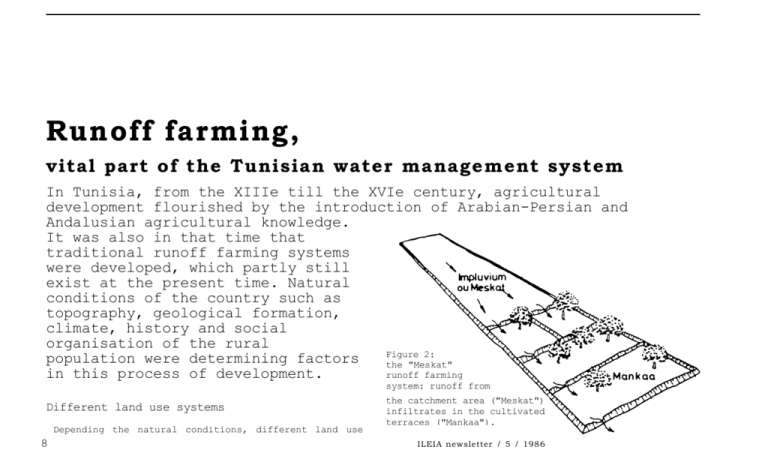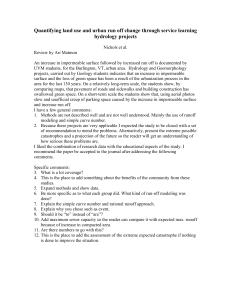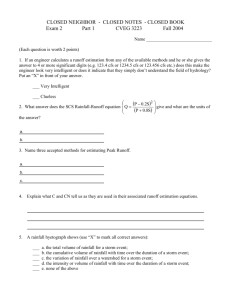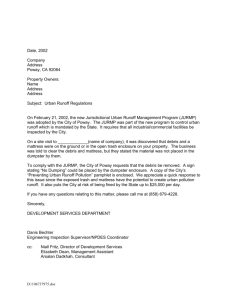Runoff farming, vital part of the Tunisian water management system
advertisement

Runoff farming, vital part of the Tunisian water management system In Tunisia, from the XIIIe till the XVIe century, agricultural development flourished by the introduction of Arabian-Persian and Andalusian agricultural knowledge. It was also in that time that traditional runoff farming systems were developed, which partly still exist at the present time. Natural conditions of the country such as topography, geological formation, climate, history and social organisation of the rural Figure 2: population were determining factors the "Meskat" in this process of development. runoff farming Different land use systems Depending the natural conditions, different land use 8 system: runoff from the catchment area ("Meskat") infiltrates in the cultivated terraces ("Mankaa"). ILEIA newsletter / 5 / 1986 systems can be recognized : L'plands are used for livestock production and forestry; Slopes are arranged by construction of terraces, contour bunds or runoff farms (Meskats) so that runoff is conserved and can be used for agriculture, erosion is controlled and water infiltration is promoted for aquifer recharge (see figure 2); In the valleys floods are checked or tapped for supplementary irrigation of agricultural land (runoff farmingJessour, see figure 3 & 4); On the Coastal plains and in Oasis, gardens are irrigated with water from aquifers. These aquifers partly are recharged with water infiltrated in the many terraces of the Meskat and Jessour systems. On the plains in Central Tunisia, floods were used for controlled inundation of agricultural land. This was a highly organised system of floodwater farming introduced by Arabic people who brought this idea from Yemen. It needed important hydraulic constructions, while management and maintenance was organised by the farmers themselves in so-called "foyers". In the colonial time, however, this system was abolished. Floodwater which is not used for runoff farming accumulates in natural depressions on the plains (sebkhats). Here the water is used for livestock production or culture of sait resistant crops like barley and atriplex. These ancient agricultural systems are deeply imbedded in the local culture which find its reflection in the many typical expressions in the local language. Runoff farming The climate of the semi-arid zone of Tunisia is characterised by a rainy winter season and a dry summer season. In the semi-arid regions of Tunesia rainfall is erratic and not sufficient for rainfed agriculture. For this reason, runoff and flood water is captured for supplementary irrigation. Depending on the geological formation and quantity of rainfall, different systems of runoff farming were developed. These systems were called Meskat and Jessour. Meskat This system can be found in the zone with 200 - 400 mm. rainfall on hilly land. At the moment there is still about 300.000 ha. agricultural land in Meskat lay-out, mostly planted with olive trees. The system consists of two distinctive parts (see fig.2): the impluvium or "Meskat", is the highest part and is used for runoff promotion. This area can be rocky with a strong slope and has a low infiltration capacity. the cultivated area or "Mankaa" is the lowest part and mostly has a deep loamy-sandy soil with a high infiltration capacity. Here the runoff of the impluvium infiltrates and makes it possible to grow crops. The cultivated ares consiste mostly of different terraces divided by earth dams with spillways of stones. The farmers made these dams rather high (0.5 m) to be sure that the highest possible daily rainfall (370 mm.) can be stored in the Manka and does not destroy the dams and hence the whole system. Unfortunately, nowadays this system deteriorates very fast. This is mainly due to the low prices for olive oil, which erodes the economic base of the system and leads to migration of the farmers. In addition, olive trees are being planted more and more on the impluvium, which is creating a disequilibrium between impluvium and cultivated land (the ratio of impluvium to cultivated land has changed from 2:1 to 1:2). The efficiency of the system is in this way diminishing and yields decrease. Maintenance fails which provokes severe erosion. This causes in its turn hugh floods on the plains, which cause much damage and the lowering of the water table in the garden zone. There are many signs that degradation of the Meskats is going to change the whole hydrological balance of the region. Jessour This system can be found in the more arid (100 - 200 mm. rainfall) and mountainous zone (see figure 3). In seasonal riverbeds, little dams of earth and stones are constructed. Soil accumulates in front of these dams so that terraces with a soil depth of 1 to 2 m are formed. On the terraces flood water is impounded and ILEIA newsletter / 5 / 1986 Fig. 3 & 4: view and profile of the "Jessour" runoff farming system: runoff-water and sediments from the hilly are captured behind the dams ("Tabia") in the valley bottom. infiltrates into the soil. This supplementary water makes agriculture in these arid regions possible. On the terraces different fruit trees, olives, almonds, dates, figs, grains and legumes are cultivated. In the region of Marmata where many Jessours can be found, rainfall is very variable (80 -700 mm./year) with possible rainfall intensities of 220 mm./day. With this kind of heavy raine in the mountains the runoff coefficient can be very high (up till 0.9 , with an average of 0,4). Depending on this coefficient, an impluvium is needed which is, on average, 5 times as large as the surface of the cultivated land. Spillways are made of dry masonry and have normally a height of one third of the height of the dams. Dams and spillways must be build very strong and maintenance must be very consistent to make this agricultural system possible. Also from the region of Marmata farmers are migrating on search for better economic opportunities. The Jessours, which need a very high labour input, are being abandoned with the same consequences as for the Meskats. Rehabilitation of runoff farming Seing conscious of the importance of runoff farming for the water management of the country, the Tunisian Gov'ernment started implementing a project to rehabilitate the Meskat and Jessour systems. Traditional techniques and modern labour saving improvements are combined to make runoff farming feasible for the economical circumstances of today. The aim of the project is not only to stabilize the waterbalance of the region but also to create work for the many unemployed. About implementation and results of this project we have no information. Information about this project or simular projects is very much welcomed by ILEIA. • Literature - El Amami, S., 1984. Les Amenagements Hydrauliques traditionnels en Tunesie. Centre de recherche du Genie Rural, Tunis, Republique Tunisienne. 9








